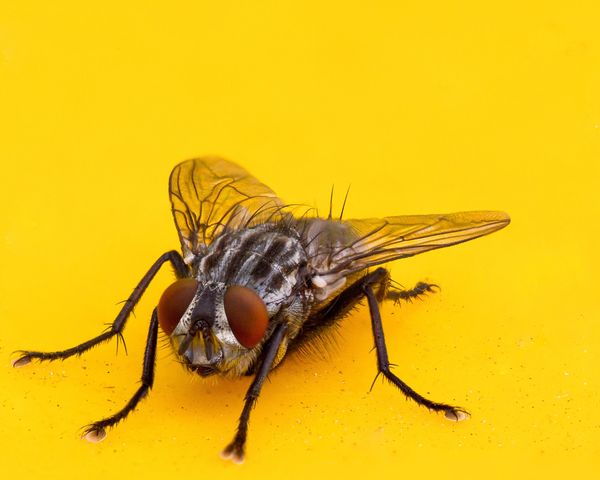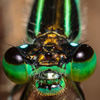Check out Digital Artistry section of our forum.
True macro
Oct 18, 2013 08:38:32 #
marklloyd1976
Loc: sydney
Hey, a quick question I have a Canon 7d and a Tamron 90mm macro which I focus stacked this fly's photo with. I was interested in trying this lens reversal thing for macro and have heard that if you use a wider focal length lens you can get greater magnification than a dedicated macro lens? Is this true. The lenses I currently own are 10-22mm, 24-105mm and a Sigma 50mm 1.4, I want to get so much better shots of just the eyes for example. I am looking at so many true macro images lately and wondering how they get so close without scaring them off? Are their bugs victims of death before a shoot also. Sorry my main question is how do I get these magnified head shots.

Oct 18, 2013 09:00:32 #
Pentony
Loc: Earth Traveller
marklloyd1976 wrote:
Hey, a quick question I have a Canon 7d and a Tamr... (show quote)
There are no quick questions. Refer to the "Search" above to see similar topics and responses.
Oct 18, 2013 09:23:40 #
This was one I took last summer....same one?
Years ago, I had a bellows that with the proper adapter, allowed me to attach a reversed wide-angle (35mm). I was over seas at the time and captured a singe lice, on a piece of tape. I then took a full-frame 35mm picture using that 'reverse lens setup. Wow! Looked like something freom a horror film
Years ago, I had a bellows that with the proper adapter, allowed me to attach a reversed wide-angle (35mm). I was over seas at the time and captured a singe lice, on a piece of tape. I then took a full-frame 35mm picture using that 'reverse lens setup. Wow! Looked like something freom a horror film

Check out Astronomical Photography Forum section of our forum.
Oct 18, 2013 09:23:47 #
marklloyd1976 wrote:
Hey, a quick question I have a Canon 7d and a Tamr... (show quote)
Check out the Macro section. Very few of the contributing photographers kill (or chill) their bugs. Many of us use extension tubes-- and some use supplemental lenses, reverse lenses, etc. It's also takes practice locating and stalking them. Early morning is great for winged insects and if you are live in an area where there is a lot of morning dew-- you can get some with dew drops all over the wings. It also helps to watch and learn insect behaviour-- because some are also creatures of habit....
Oct 18, 2013 20:16:02 #
I used a Sigma 18-250 micro lens. It is not a true micro in that it does not truly magnify the subject but it does allow you to get cclose
Oct 18, 2013 21:52:15 #
Quick answer, you want really good head shots of insects at magnifications greater than 1:1 and don't want to deal with tubes, bellows, a reversed lens on a zoom, etc. get an MP-E 65 1X-to-5X for your 7D. You will be hard pressed to get the image quality it captures in a package that is easy to physically handle in the field. With practice one can shot 3:1 hand held. That said it isn't an easy lens to master. Then again all hand held magnification rigs take effort to master.
If you are on a budget or like tinkering and really want to learn how varying focal lengths effect magnification, work with what you have. Here's what you can expect with your current lens lineup:
1) 50mm best image quality less magnification per mm distance from the sensor then the 10-22mm wide angle.
2) 10-22mm will give you higher magnification per mm from the sensor then the other two lenses. You will experience more image degradation than the 50mm prime.
3) 24-105 less magnification then the other wide angle. Image quality between the two wide angles will be close. As you zoom out magnification will decrease.
To reverse mount you are going to need a reverse EOS mount adapter with thread on the other end that matches the filter thread of your lens. These are easily found on EBay or Amazon. Be sure to get one made of metal, preferably brass.
To give you an idea what you can do (magnification wise) here is a setup I did with a 15-150mm zoom lens mounted on bellows:
http://www.uglyhedgehog.com/t-150660-1.html
As for photographing live bugs at high magnification, it can be done. It just takes observation, patience, and practice, practice, practice. When you have some time stop by the macro forum and post any questions you may have. Wealth of information in the group.
If you are on a budget or like tinkering and really want to learn how varying focal lengths effect magnification, work with what you have. Here's what you can expect with your current lens lineup:
1) 50mm best image quality less magnification per mm distance from the sensor then the 10-22mm wide angle.
2) 10-22mm will give you higher magnification per mm from the sensor then the other two lenses. You will experience more image degradation than the 50mm prime.
3) 24-105 less magnification then the other wide angle. Image quality between the two wide angles will be close. As you zoom out magnification will decrease.
To reverse mount you are going to need a reverse EOS mount adapter with thread on the other end that matches the filter thread of your lens. These are easily found on EBay or Amazon. Be sure to get one made of metal, preferably brass.
To give you an idea what you can do (magnification wise) here is a setup I did with a 15-150mm zoom lens mounted on bellows:
http://www.uglyhedgehog.com/t-150660-1.html
As for photographing live bugs at high magnification, it can be done. It just takes observation, patience, and practice, practice, practice. When you have some time stop by the macro forum and post any questions you may have. Wealth of information in the group.
Oct 19, 2013 03:10:24 #
marklloyd1976
Loc: sydney
Thanks to all replies you have all been great I was tthinking of the mpe 65 and lots of practice
Oct 19, 2013 12:12:36 #
Short of using fly paper, how do you get the fly (or any insect) to sit still for multiple exposures?? Wonderful detail in your shot!
Oct 19, 2013 16:29:07 #
I have the Canon 100mm macro. I recently purchased a cheap adapter that allows me to reverse mount my 30 yr old Mamiya 55mm f/1.8 to the front of the 100mm. The magnification is great, and the images are sharp, but focusing can be very difficult at this magnification and shallow DOF. With this technique, all of the "auto" stuff still works, like AF.
Oct 20, 2013 07:17:41 #
sb wrote:
Short of using fly paper, how do you get the fly (or any insect) to sit still for multiple exposures?? Wonderful detail in your shot!
Exactly, I think they freeze them . :thumbup:
Oct 20, 2013 09:47:32 #
While there is no doubt some macro photographers chill insects to immobilize them for stacking. I have seen results from others (fstop22 and steve1oshea regular UHH macro posters come to mind) who do handheld stacks at 1:1 and 2:1 on live critters. It really doesn't take a lot of frames (focus bands) to pull it off. Just need a quick clicker finger, a very steady hand and a good eye to pull it off.
I have been working on the technique and while I have come close, I haven't pulled off a handheld stack that I am satisfied with, yet. I have pulled off decent field stacks, up to 3:1, using a tripod-rig with a very alive damsel fly. Albeit freshly transformed and probably scared as all get-go so it didn't move. Results may be seen here:
http://www.uglyhedgehog.com/t-140924-1.html
When you see stacks that start pushing into the 4:1 range and higher, more than likely the critter was dead, chilled, slow moving, or like in the case of my stacks, immobilized for some natural reason.
I have been working on the technique and while I have come close, I haven't pulled off a handheld stack that I am satisfied with, yet. I have pulled off decent field stacks, up to 3:1, using a tripod-rig with a very alive damsel fly. Albeit freshly transformed and probably scared as all get-go so it didn't move. Results may be seen here:
http://www.uglyhedgehog.com/t-140924-1.html
When you see stacks that start pushing into the 4:1 range and higher, more than likely the critter was dead, chilled, slow moving, or like in the case of my stacks, immobilized for some natural reason.
murm wrote:
Exactly, I think they freeze them . :thumbup:
If you want to reply, then register here. Registration is free and your account is created instantly, so you can post right away.
Check out Drone Video and Photography Forum section of our forum.




